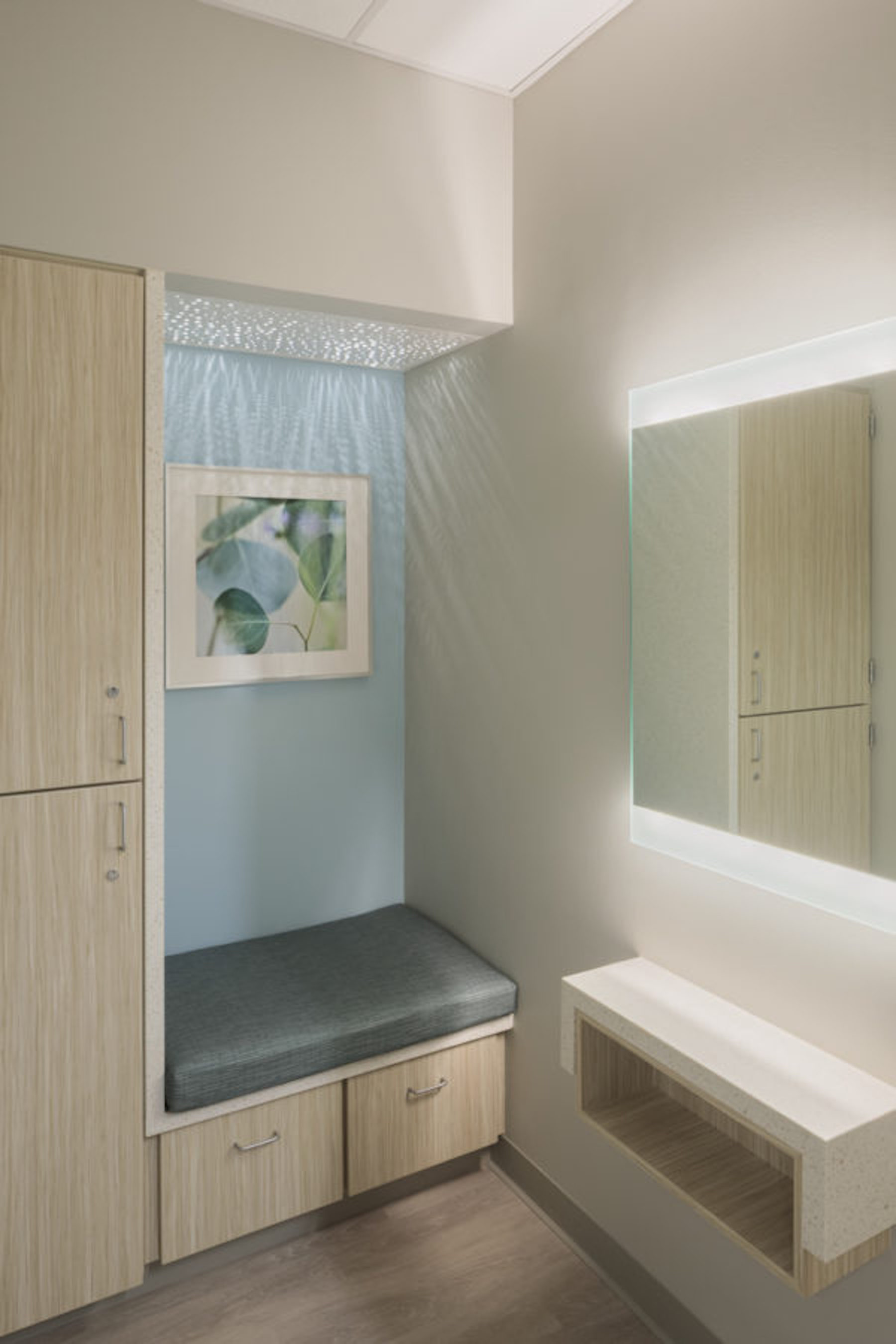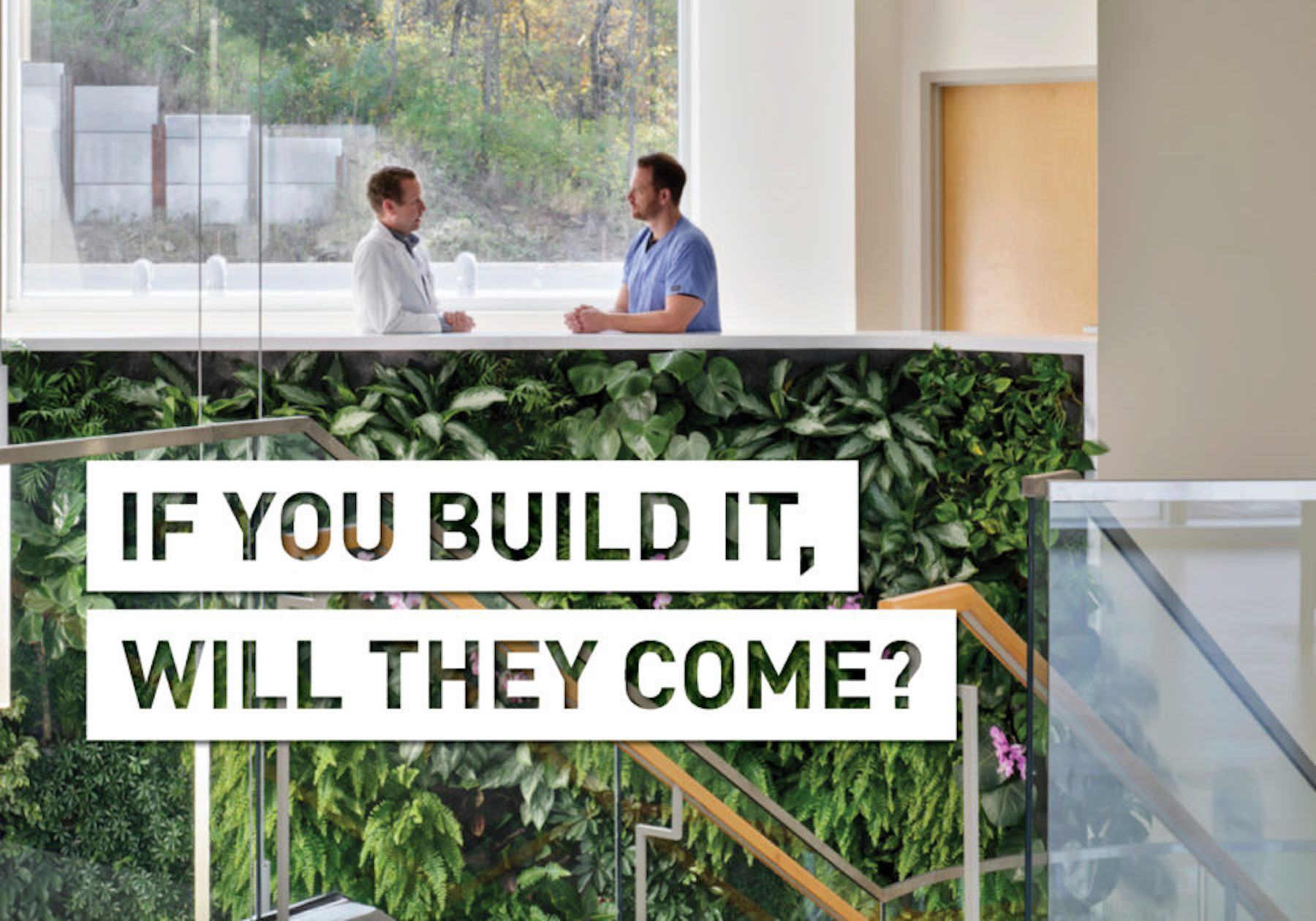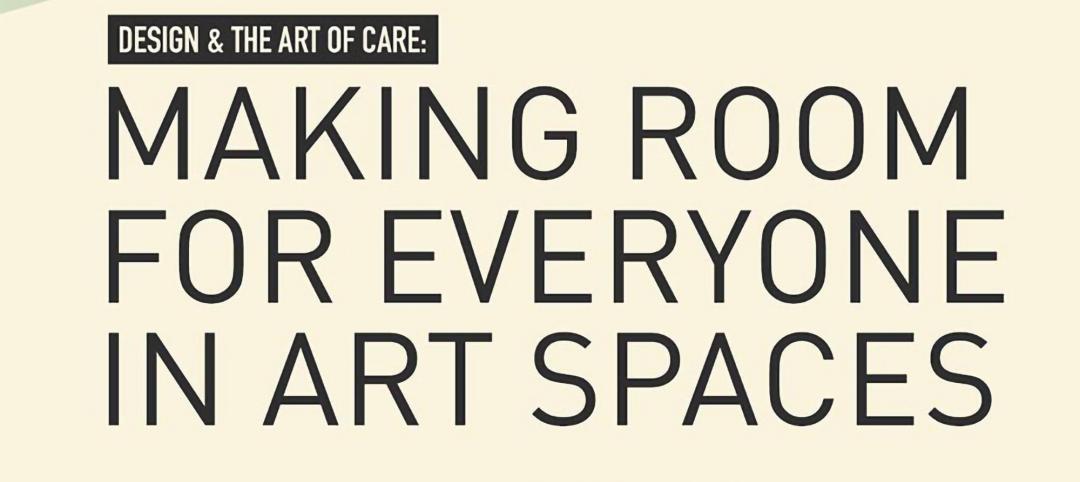Architects and designers have long argued for the value of respite spaces in healthcare facilities. We often discuss their value for patients, but they’re especially valuable for staff.
The Need for Respite.
The fact is healthcare workers are under a tremendous amount of stress. The numbers speak for themselves. In 2021, 61% of physicians reported experiencing burnout. That’s up from 40% in 2018, which was already a substantial number. And while 1 in 5 healthcare workers have left their jobs in the last couple of years, a recent survey from the American Nurses Foundation shows that 50% of nurses say they’re considering leaving their jobs.
Caused by a number of factors (long hours, overwork, lack of sleep, working in a high-stress environment, and feeling unsupported), staff burnout is real. It not only leaves workers feeling depleted and disconnected from their jobs, but it costs hospitals millions of dollars every year. Pre-pandemic estimates of the annual cost of nurse turnover ranged from $5.2 M to $8.1 M per hospital. Its human cost—the toll it takes on workers—is also profound.
The Problem with Respite Spaces.
These statistics suggest that more needs to be done to support the physical and mental well-being of healthcare workers. This problem cannot be solved by design alone, but design can help.
1. That said, spaces that are designed for respite frequently go unused. As Lanie Francis, MD observed during GBBN’s Oncology Symposium earlier this year, “It’s been very challenging to get people into those spaces, particularly now when everyone is overworked and understaffed…. There is a tendency to think that we just need to create those spaces, and if you build it, they will come. But I think our challenge is to be more thoughtful about… what really works for staff.”
Post Occupancy Evaluations (POEs) of our own designs (and observations of others’) confirms this. Space that was built to provide a moment of rest is frequently repurposed. For instance, we’ve seen nicely-detailed respite spaces that were repurposed as storage or claimed as private offices.
It might be tempting to conclude that respite simply isn’t desired in healthcare spaces. We’ve been in plenty of focus groups where healthcare staff struggle to imagine why they would need it. But we don’t think it’s so simple.
2. Even when they lack “respite space,” healthcare workers often develop creative ways of adapting the way they interact with existing spaces to provide for moments of respite.
A recent study of three Emergency Departments from Shabboo Valipoor and Sheila Bosch showed that the breakroom was only the fifth most likely place that workers would go to in order to step away from the demands of work. What is especially striking about this study was that the bathroom ranked first. This illustrates two points:
- First, there is a need for respite space (even if what's currently being built doesn't seem to satisfy that need.) Healthcare workers are managing their stress through these kinds of informal practices. Whether you think of the nurse visiting an unvisited hallway or the worker who stops into the bathroom to cry, collect themselves, and fix their appearance before returning to work, both circumstances illustrate the need for respite. Each also shows that healthcare workers feel they cannot express that need.
- It is less a spatial issue than it is a culture one. Celebrating "toughness" and "sticking it out," the healthcare industry is suffering from a stigma around workers expressing their needs. Needing a break is viewed as "weakness." If healthcare workers feel they must hide in the bathroom to get a minute for themselves, they clearly need respite. They just feel that they can't show it. It is not surprising, then, that they don't visit spaces that are expressly designed for that need.
Design Solutions.
What does this mean for design? First, designers and their clients need to think beyond the concept of “respite space” as a destination. Not that there shouldn’t be destinations (e.g., convenient, relaxing places to take a break), but that we should look for opportunities to bring respite to healthcare workers where they are.

Perhaps it sounds strange, but if healthcare workers are finding respite in the bathroom, we should consider investing there. Can you provide extra soundproofing, ambient noise, or richer material finishes that help that space bring increased comfort? If healthcare workers are finding their respite by walking long corridors, that’s another opportunity. Designers can alter lighting conditions and acoustic treatments to increase the comfort of those spaces as well. We can also provide back of house spaces that are on the unit that have salutogenic (health-generating) elements like positive distraction. This can provide respite without taking healthcare providers away from their work. Within a staff-only corridor of an infusion unit at Christus St. Vincent, for instance, we located a hydration station, lowered ceilings, and provided a bit of privacy to create a comfortable, sheltered space for staff to linger while claiming a moment for themselves.
Nurse’s stations also provide important opportunities for decreasing stress. To provide more patient-centered care, most health systems are embracing decentralized nurse’s stations. Unfortunately, Post Occupancy Evaluations that we’ve conducted have shown that this can increase a feeling of isolation and of being unsupported, which feeds into the problem of burnout. As designers, we can take steps to increase visibility between stations, fostering situational awareness and increasing communication between coworkers. In short, we can help healthcare workers support one another.
Culture Change.
For respite spaces that might be thought of more as “destinations” (courtyards, planted balconies, private “phonebooths,” and so on), there is a crucial consideration that goes beyond design. That’s culture. We fully believe in the value of these kinds of spaces but making them work within a given space frequently requires a shift in workplace culture.
It requires administration buy-in. Leadership should demonstrate the value of these kinds of spaces by championing them and using them. Doing so demonstrates that it is okay to take a moment for oneself. Structuring in breaks for patient-facing staff would also help shift the culture. It is about more than the value of the space. It’s an acknowledgement that we all have human needs, and that your workplace culture can support that.
We’ve seen enough workplace renovations to know that a new space can work wonders in shifting the experience of workers, but we also know that it frequently requires intentional effort to develop new habits. With the levels of stress and burnout rates the healthcare industry faces, it’s time for some healthier habits.
More from Author
GBBN | Sep 12, 2024
How space supports programming changes at university libraries
GBBN Associate Sarah Kusuma Rubritz, AIA, uses the University of Pittsburgh's Hillman Library to showcase how libraries are transforming to support students’ needs.
GBBN | Jul 3, 2024
New science, old buildings: Renovating for efficiency, flexibility, and connection
What does the research space of the future look like? And can it be housed in older buildings—or does it require new construction?
GBBN | Jun 3, 2024
Insights for working well in a hybrid world
GBBN Principal and Interior Designer Beth Latto, NCIDQ, LEED AP, ID+C, WELL AP, share a few takeaways, insights, and lessons learned from a recent Post Occupancy Evaluation of the firm's Cincinnati, Ohio, office.
GBBN | Feb 26, 2024
GBBN's Inflation Reduction Act Calculator goes live
GBBN has publicly released its IRA Calculator, a tool that helps you understand funding opportunities in the IRA for sustainable design.
GBBN | Jan 25, 2024
Tactical issues for renovating university research buildings
Matthew Plecity, AIA, ASLA, Principal, GBBN, highlights the connection between the built environment and laboratory research, and weighs the benefits of renovation vs. new construction.
GBBN | Dec 14, 2023
What's next for affordable housing in 2024?
As 2023 draws to a close, GBBN’s Mary Jo Minerich and Amanda Markovic, AIA sat down to talk about the future. What’s next in terms of trends, technology, and construction of affordable housing?
GBBN | Oct 11, 2023
Leveraging land and light to enhance patient care
GBBN interior designer Kristin Greeley shares insights from the firm's latest project: a cancer center in Santa Fe, N.M.
GBBN | Aug 31, 2023
Small town takes over big box
GBBN associate Claire Shafer, AIA, breaks down the firm's recreational adaptive reuse project for a small Indiana town.
GBBN | Jun 20, 2023
Designing arts spaces that curate inclusivity
GBBN's Julia Clements and Marcene Kinney, AIA, LEED AP, talk tips for designing inclusive arts spaces.
GBBN | Mar 22, 2023
Onsite prefabrication for healthcare construction: It's more than a process, it's a partnership
Prefabrication can help project teams navigate an uncertain market. GBBN's Mickey LeRoy, AIA, ACHA, LEED AP, explains the difference between onsite and offsite prefabrication methods for healthcare construction projects.
















